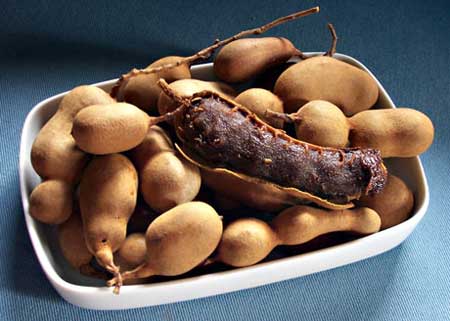Tamarind is believed to originate in East African but now grows widely in India, South East Asian, and the West Indies. In the Hindu Mythology, tamarind means “date of India” and it is associated with the ceremony of god Krishna which is usually celebrated in the month of November across India.
Tamarind fruit is the sticky pulp found on a curved brown bean like-pod from a tamarind tree. The pulp has a sweet and sour taste and is a major component in most of the Southeast Asian and some Indian recipes.

In addition to adding flavor, tamarind can also be used in a marinade. Its natural acidity does wonders in tenderizing tougher cuts of beef, breaking down the fibers in the beef to make it softer.
The beef will become succulent and very tender when left overnight in a tamarind-tinged liquid. But you need to exercise extra caution when marinating chicken or fish: don’t leave in the marinade too long since the marinade can begin to cook the meat chemically.
How to Choose Tamarind
The best places to find tamarind is in specialty markets dealing with Indian, Southeast Asian and Mexican foods. It is also important to note that you can find tamarind in different forms, the choice of which will be dictated by your intended use of the fruit. The most common forms of tamarind include-:
- Whole dried pods – these are packed in cellophane bags. Requires extra work if you needed to use the tamarind as a paste.
- Compressed tamarind – Composed of tamarind pulp compressed into 1lb blocks. They may or may not have seeds. A compressed tamarind is a great option when you need to prepare tamarind paste. Though it involves s little work in extracting the paste, it is worth the time since it will give you a better flavor compared to the already manufactured pastes.
- Frozen, unsweetened pulp – this is usually packed in 14-oz pouches and is great where you need thinner, less intense tamarind flavors in your dishes.
- Frozen tamarind nectar – this is ready to use tamarind packaged in 12-oz cans or bottles. Since it is already sweetened, you can dilute it into iced drinks for a fresh burst of energy.
- Tamarind concentrate – this is a thick, dark unsweetened ready to use tamarind paste usually packed in 8-oz plastic jars. It dissolves easily, and it is the one commonly used in most of the Southeast Asian delicacies. If you want to use it in your cooking, you are strongly advised to avoid concentrates that have artificial colors, flavors or sweeteners. You won’t manage to get the authentic tamarind flavor from such concentrates.
Substitutes for tamarind
In case, you needed to use tamarind but you can’t find it in any of the forms above, there are a couple of substitutes you could use. These will not give you the authentic tamarind flavor, but you will still get the sourness and briskness you needed in your meals. Some of the popular substitutes include lemon or lime juice, a mixture of sugar and vinegar and a mixture of dried fruits such as apricots, dates, green mangoes, and lemon.